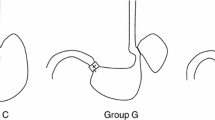Summary
Reflux esophagitis was successfully produced in all rats operated on by total gastrectomy and esophagojejunostomy. Its histopathological features comprised erosion and ulceration associated with inflammatory cell infiltration, with hyperplasia of the mucosal epithelium in some animals. These rats were dosed with sodium polyacrylate for protecting the mucosal surface, underwent jejunal diversion for preventing the reflux of digestive juice, or were treated with both in combination, to observe the repairing status of the esophageal ulcer, using the ratio of the length of the regenerated epithelium in the ulcer to the length of the ulcer as the index for the degree of repair.
The oral ingestion of 5% sodium polyacrylate solution in drinking water proved the most effective means of administration of this agent. The repair was more improved greater in the group undergoing jejunal diversion, and was greatest in the group receiving both in combination.
From these findings, oral administration of a mucosal surface protector, sodium polyacrylate, is an effective therapeutic regimen in mild cases of reflux esophagitis following total gestrectomy, as well as elimination of the cause by diversion of the route in severe cases. The combination of the two therapies will probably be the most effective therapeutic means for this disease.
Similar content being viewed by others
References
Allison PR (1951) Reflux esophagitis, sliding hiatal hernia, and anatomy of repair. Surg Gynecol Obstet 92:419–431
Barrett NR (1950) Chronic peptic ulcer of the esophagus and esophagitis. Br J Surg 39:175–182
Cross FS, Wangensteen OH (1961) The role of bile and pancreatic juice in production of esophageal erosion and anemia. Proc Soc Exp Biol Med 77:862–866
Ellis FH, Hood RT (1954) Experimental esophagogastrectomy. Relation of type of resection to development of esophagitis. Surg Gynecol Obstet 98:449–455
Ferguson DJ, Sanchez-Talomera E, Sako Y, Clatworthy HW, Toon OW, Wangensteen OH (1950) Studies on experimental esophagitis. Surgery 28:1022–1039
Gillison EW, Castro VAM, Nyhus LM, Kusakari K, Bomback CT (1972) The significance of bile in reflux esophagitis. Surg Gynecol Obstet 134:419–424
Helsingen N Jr (1959/1960) Oesophageal lesions following total gestrectomy in rats. Acta Chir Scand 118:202–216
Henderson RD, Mugashe F, Jeejeebhoy KN, Cullen J, Szcepanky M, Boszko A, Marryatt G (1972) The role of bile and acid in the production of esophagitis and the motor defect of esophagitis. Ann Thorac Surg 14:465–473
Hoag EW, Kiriluk LB, Merendino KA (1954) Experiences with upper gastrectomy. Its relationship to esophagitis with special reference to the esophagogastric junction and diaphragm — A study in the dog. Am J Surg 88:44–55
Ishii Y, Fujii Y, Yamashita T (1981) Effect of sodium polyacrylate on chronic reflux esophagitis in rats. Arzneimittelforsch 31:2112–2115
Kiriluk LB, Merendino KA (1951) An experimental evaluation in the dog of esophagogastrostomy for the highlying gastric ulcer. Ann Surg 134:918–923
Kokue E, Hayama T, Nakamura T (1974) Antiulcerogenic property of sodium polyacrylate on experimental ulcerations in rats. Jpn J Pharmacol 24:621–626
Kokue E, Takahashi Y (1976) Protective effect of sodium polyacrylate on induced duodenal ulceration in guinea pigs. Jpn J Pharmacol 26:760–762
Kuramoto S (1961) Studies on the anti-reflux mechanism existing at the esophagogastric junction. Experimental analysis on some factors participating in the mechanism (in Japanese). Nippon Shokaki Geka Gakkai Zasshi 62:615–626
Lambert R (1962) Relative importance of biliary and pancreatic secretions in the genesis of esophagitis in rats. Am J Dig Dis 7:1026–1033
Moffact RC, Berkas EM (1965) Bile esophagitis. Arch Surg 91:963–966
Nauta J (1956) The closing mechanism between the esophagus and the stomach. Gastroenterologia 86:219–232
Redo SF, Barnes WA, Sierra AO (1959) Perfusion of the canine esophagus with secretions of the upper gastrointestinal tract. Ann Surg 149:556–564
Selye (1938) The experimental production of peptic hemorrhagic esophagitis. Can Med Assoc J 39:447–448
Shima S (1971) An experimental study on the reflux preventive mechanism on the gastroesophageal junction (in Japanese). Nippon Kyobu Geka Gakkai Zasshi 19:112–125
Smiddy FG, Atkinson M (1959) Mechanisms preventing gastroesophageal reflux in the dog. Br J Surg 47:680–687
Tamura F (1960) Reflux esophagitis in esophagogastrostomy — An experimental study (in Japanese). Nagasaki Igakkai Zasshi 35:903–917
Winkelstein A (1935) Peptic esophagitis — A new clinical entity. JAMA 104:906–909
Author information
Authors and Affiliations
Additional information
The present paper was read in summarized form at the 6th International Congress of Gastroenterological Surgery, Lisbon, September 1980
Rights and permissions
About this article
Cite this article
Uchida, Y., Luo, T.Y., Azekura, K. et al. Experimental studies of reflux esophagitis following total gastrectomy in rats — pathogenesis and treatment. Res. Exp. Med. 181, 1–10 (1982). https://doi.org/10.1007/BF01850984
Received:
Accepted:
Issue Date:
DOI: https://doi.org/10.1007/BF01850984



